warning lights RENAULT TWINGO 2017 3.G Owner's Manual
[x] Cancel search | Manufacturer: RENAULT, Model Year: 2017, Model line: TWINGO, Model: RENAULT TWINGO 2017 3.GPages: 228, PDF Size: 6.76 MB
Page 100 of 228
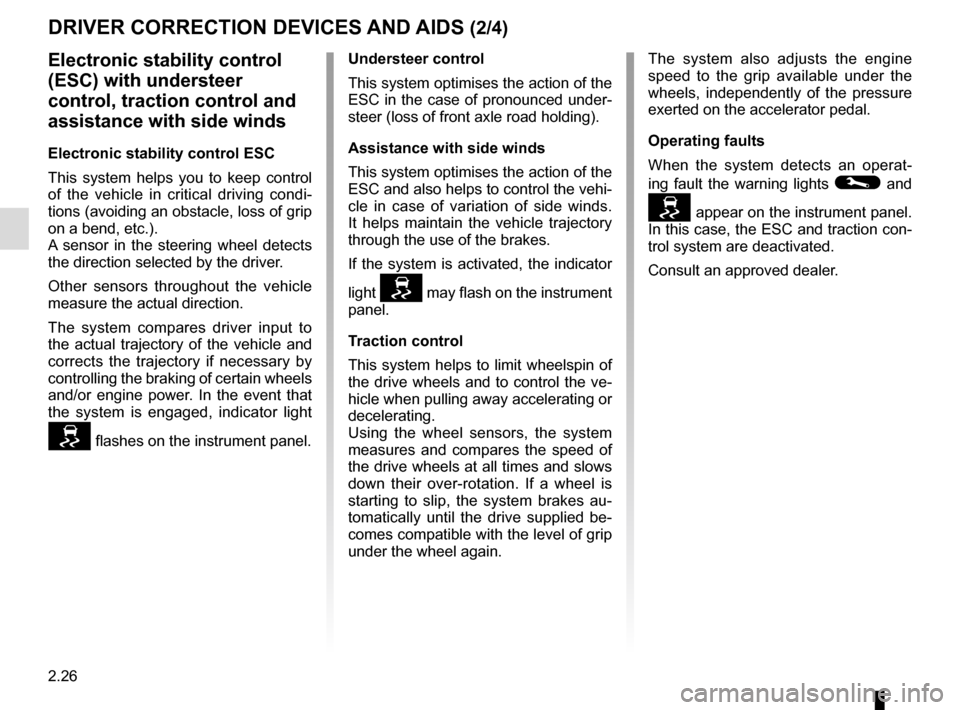
2.26
Electronic stability control
(ESC) with understeer
control, traction control and
assistance with side winds
Electronic stability control ESC
This system helps you to keep control
of the vehicle in critical driving condi-
tions (avoiding an obstacle, loss of grip
on a bend, etc.).
A sensor in the steering wheel detects
the direction selected by the driver.
Other sensors throughout the vehicle
measure the actual direction.
The system compares driver input to
the actual trajectory of the vehicle and
corrects the trajectory if necessary by
controlling the braking of certain wheels
and/or engine power. In the event that
the system is engaged, indicator light
flashes on the instrument panel.
DRIVER CORRECTION DEVICES AND AIDS (2/4)
Understeer control
This system optimises the action of the
ESC in the case of pronounced under-
steer (loss of front axle road holding).
Assistance with side winds
This system optimises the action of the
ESC and also helps to control the vehi-
cle in case of variation of side winds.
It helps maintain the vehicle trajectory
through the use of the brakes.
If the system is activated, the indicator
light
may flash on the instrument
panel.
Traction control
This system helps to limit wheelspin of
the drive wheels and to control the ve-
hicle when pulling away accelerating or
decelerating.
Using the wheel sensors, the system
measures and compares the speed of
the drive wheels at all times and slows
down their over-rotation. If a wheel is
starting to slip, the system brakes au-
tomatically until the drive supplied be-
comes compatible with the level of grip
under the wheel again. The system also adjusts the engine
speed to the grip available under the
wheels, independently of the pressure
exerted on the accelerator pedal.
Operating faults
When the system detects an operat-
ing fault the warning lights
© and
appear on the instrument panel.
In this case, the ESC and traction con-
trol system are deactivated.
Consult an approved dealer.
Page 101 of 228
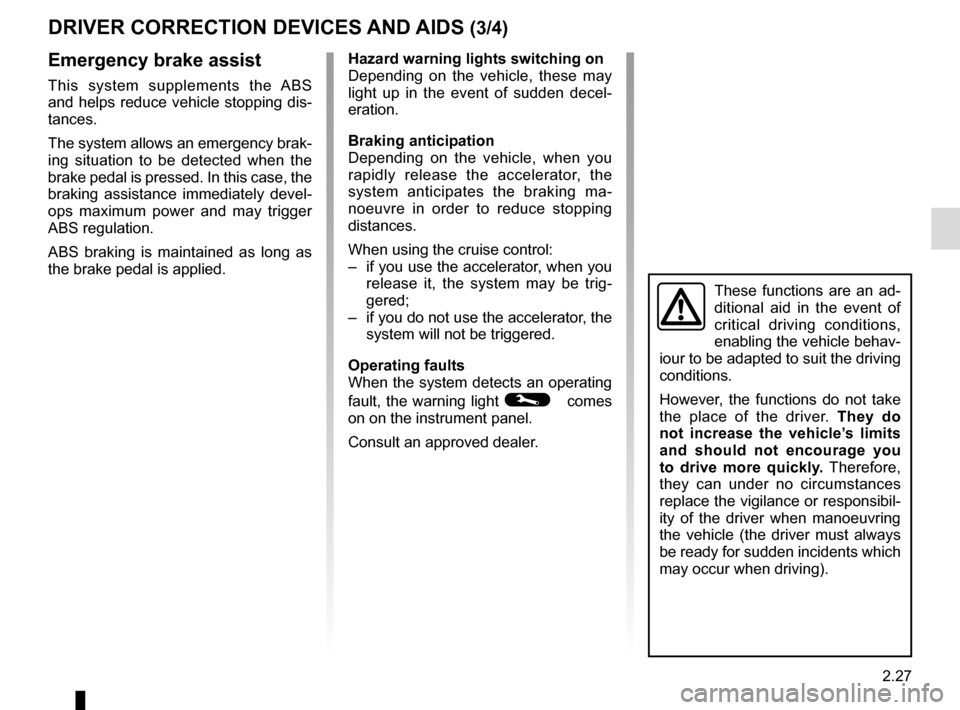
2.27
DRIVER CORRECTION DEVICES AND AIDS (3/4)
Emergency brake assist
This system supplements the ABS
and helps reduce vehicle stopping dis-
tances.
The system allows an emergency brak-
ing situation to be detected when the
brake pedal is pressed. In this case, the
braking assistance immediately devel-
ops maximum power and may trigger
ABS regulation.
ABS braking is maintained as long as
the brake pedal is applied.Hazard warning lights switching on
Depending on the vehicle, these may
light up in the event of sudden decel-
eration.
Braking anticipation
Depending on the vehicle, when you
rapidly release the accelerator, the
system anticipates the braking ma-
noeuvre in order to reduce stopping
distances.
When using the cruise control:
– if you use the accelerator, when you
release it, the system may be trig-
gered;
– if you do not use the accelerator, the system will not be triggered.
Operating faults
When the system detects an operating
fault, the warning light
© comes
on on the instrument panel.
Consult an approved dealer.
These functions are an ad-
ditional aid in the event of
critical driving conditions,
enabling the vehicle behav-
iour to be adapted to suit the driving
conditions.
However, the functions do not take
the place of the driver. They do
not increase the vehicle’s limits
and should not encourage you
to drive more quickly. Therefore,
they can under no circumstances
replace the vigilance or responsibil-
ity of the driver when manoeuvring
the vehicle (the driver must always
be ready for sudden incidents which
may occur when driving).
Page 104 of 228
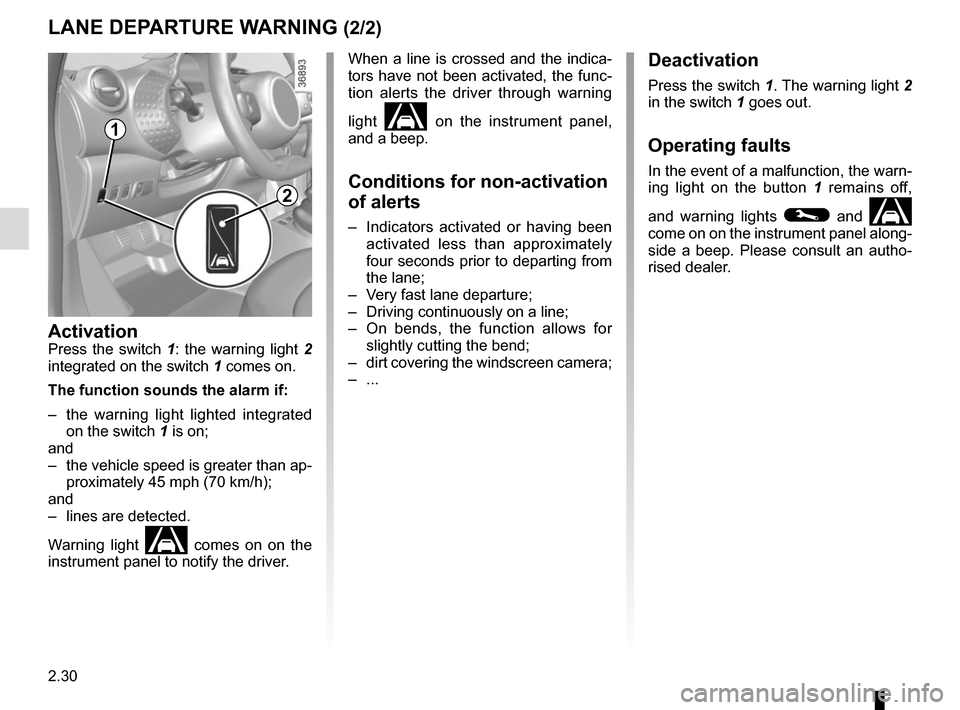
2.30
LANE DEPARTURE WARNING (2/2)Deactivation
Press the switch 1. The warning light 2
in the switch 1 goes out.
Operating faults
In the event of a malfunction, the warn-
ing light on the button 1 remains off,
and warning lights
© and
come on on the instrument panel along-
side a beep. Please consult an autho-
rised dealer.
When a line is crossed and the indica-
tors have not been activated, the func-
tion alerts the driver through warning
light
on the instrument panel,
and a beep.
Conditions for non-activation
of alerts
– Indicators activated or having been activated less than approximately
four seconds prior to departing from
the lane;
– Very fast lane departure;
– Driving continuously on a line;
– On bends, the function allows for slightly cutting the bend;
– dirt covering the windscreen camera;
– ...
ActivationPress the switch 1: the warning light 2
integrated on the switch 1 comes on.
The function sounds the alarm if:
– the warning light lighted integrated on the switch 1 is on;
and
– the vehicle speed is greater than ap- proximately 45 mph (70 km/h);
and
– lines are detected.
Warning light
comes on on the
instrument panel to notify the driver.
1
2
Page 111 of 228
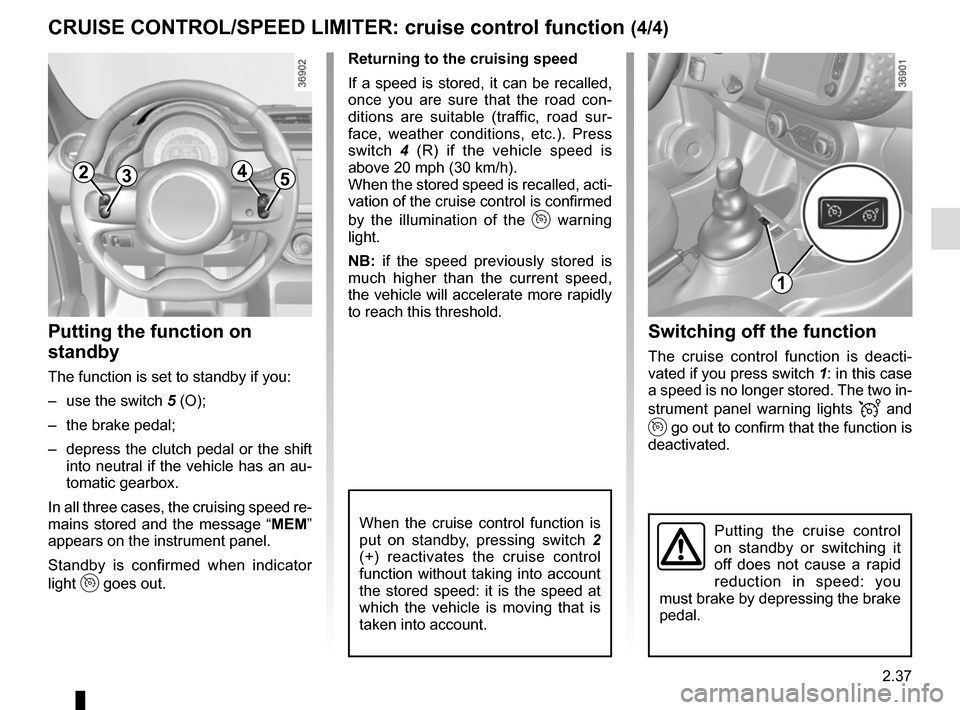
2.37
Switching off the function
The cruise control function is deacti-
vated if you press switch 1: in this case
a speed is no longer stored. The two in-
strument panel warning lights
and
go out to confirm that the function is
deactivated.
Returning to the cruising speed
If a speed is stored, it can be recalled,
once you are sure that the road con-
ditions are suitable (traffic, road sur-
face, weather conditions, etc.). Press
switch
4 (R) if the vehicle speed is
above 20 mph (30 km/h).
When the stored speed is recalled, acti-
vation of the cruise control is confirmed
by the illumination of the
warning
light.
NB: if the speed previously stored is
much higher than the current speed,
the vehicle will accelerate more rapidly
to reach this threshold.
When the cruise control function is
put on standby, pressing switch 2
(+) reactivates the cruise control
function without taking into account
the stored speed: it is the speed at
which the vehicle is moving that is
taken into account.
Putting the function on
standby
The function is set to standby if you:
– use the switch 5 (O);
– the brake pedal;
– depress the clutch pedal or the shift into neutral if the vehicle has an au-
tomatic gearbox.
In all three cases, the cruising speed re-
mains stored and the message “ MEM”
appears on the instrument panel.
Standby is confirmed when indicator
light
goes out.
CRUISE CONTROL/SPEED LIMITER: cruise control function (4/4)
Putting the cruise control
on standby or switching it
off does not cause a rapid
reduction in speed: you
must brake by depressing the brake
pedal.
2354
1
Page 171 of 228
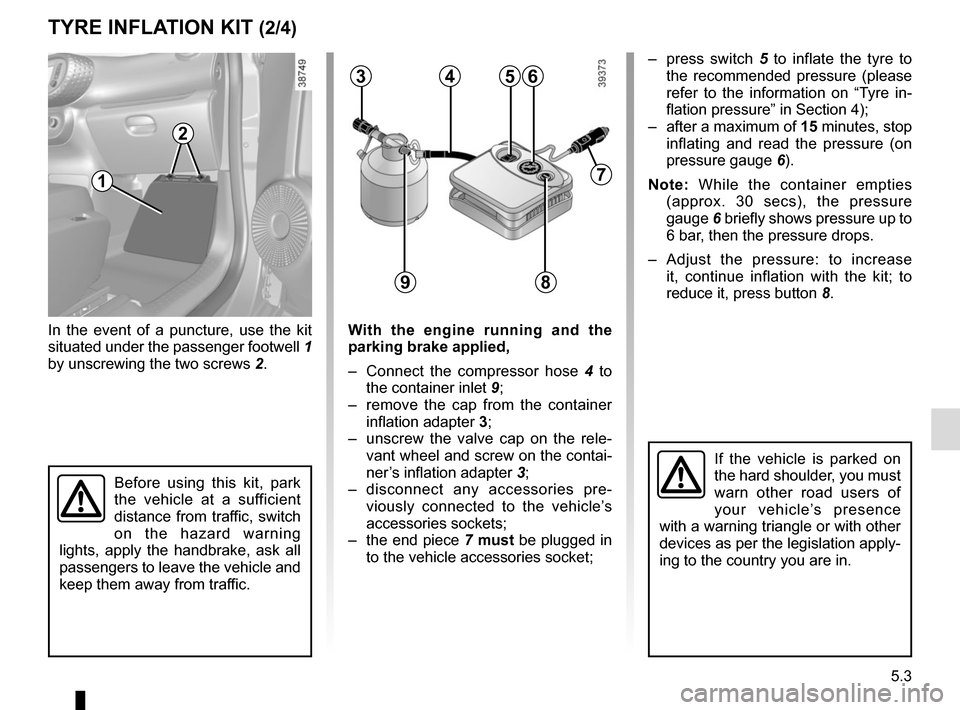
5.3
TYRE INFLATION KIT (2/4)
In the event of a puncture, use the kit
situated under the passenger footwell 1
by unscrewing the two screws 2.With the engine running and the
parking brake applied,
– Connect the compressor hose 4 to
the container inlet 9;
– remove the cap from the container inflation adapter 3;
– unscrew the valve cap on the rele- vant wheel and screw on the contai-
ner’s inflation adapter 3;
– disconnect any accessories pre- viously connected to the vehicle’s
accessories sockets;
– the end piece 7 must be plugged in
to the vehicle accessories socket;
563
Before using this kit, park
the vehicle at a sufficient
distance from traffic, switch
on the hazard warning
lights, apply the handbrake, ask all
passengers to leave the vehicle and
keep them away from traffic.
9
If the vehicle is parked on
the hard shoulder, you must
warn other road users of
your vehicle’s presence
with a warning triangle or with other
devices as per the legislation apply-
ing to the country you are in.
– press switch 5 to inflate the tyre to
the recommended pressure (please
refer to the information on “Tyre in-
flation pressure” in Section 4);
– after a maximum of 15 minutes, stop inflating and read the pressure (on
pressure gauge 6).
Note: While the container empties (approx. 30 secs), the pressure
gauge 6 briefly shows pressure up to
6 bar, then the pressure drops.
– Adjust the pressure: to increase it, continue inflation with the kit; to
reduce it, press button 8.
7
4
8
1
2
Page 194 of 228
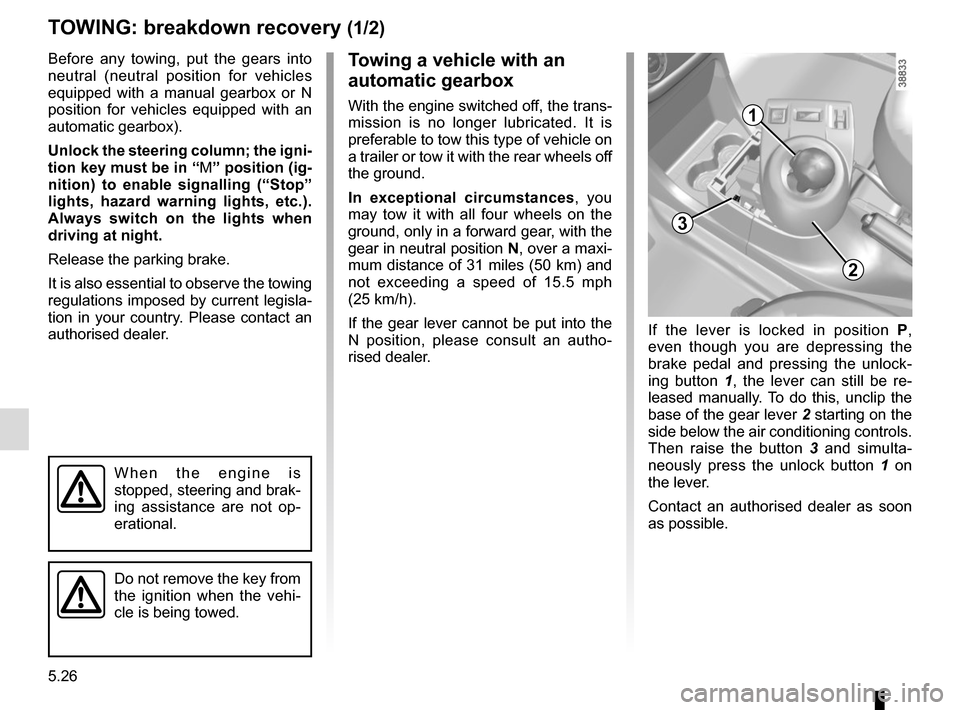
5.26
TOWING: breakdown recovery (1/2)
Towing a vehicle with an
automatic gearbox
With the engine switched off, the trans-
mission is no longer lubricated. It is
preferable to tow this type of vehicle on
a trailer or tow it with the rear wheels off
the ground.
In exceptional circumstances, you
may tow it with all four wheels on the
ground, only in a forward gear, with the
gear in neutral position N, over a maxi-
mum distance of 31 miles (50 km) and
not exceeding a speed of 15.5 mph
(25 km/h).
If the gear lever cannot be put into the
N position, please consult an autho-
rised dealer.1
2
Before any towing, put the gears into
neutral (neutral position for vehicles
equipped with a manual gearbox or N
position for vehicles equipped with an
automatic gearbox).
Unlock the steering column; the igni-
tion key must be in “ M” position (ig-
nition) to enable signalling (“Stop”
lights, hazard warning lights, etc.).
Always switch on the lights when
driving at night.
Release the parking brake.
It is also essential to observe the towing
regulations imposed by current legisla-
tion in your country. Please contact an
authorised dealer.
When the engine is
stopped, steering and brak-
ing assistance are not op-
erational.
Do not remove the key from
the ignition when the vehi-
cle is being towed.
3
If the lever is locked in position P ,
even though you are depressing the
brake pedal and pressing the unlock-
ing button 1 , the lever can still be re-
leased manually. To do this, unclip the
base of the gear lever 2 starting on the
side below the air conditioning controls.
Then raise the button 3 and simulta-
neously press the unlock button 1 on
the lever.
Contact an authorised dealer as soon
as possible.
Page 222 of 228
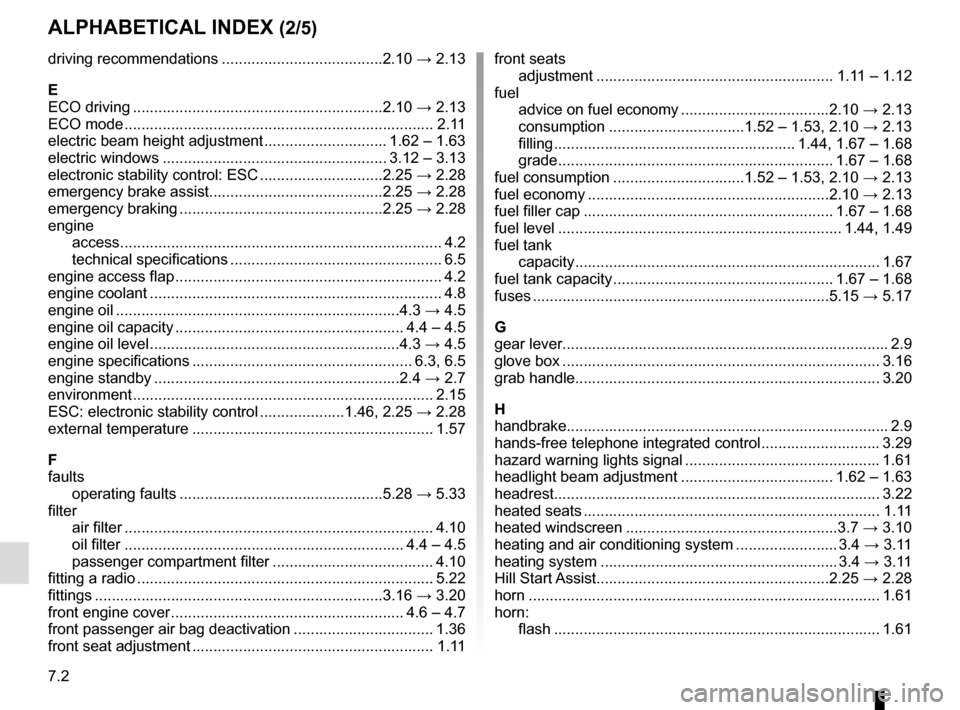
7.2
ALPHABETICAL INDEX (2/5)
driving recommendations ......................................2.10 → 2.13
E
ECO driving ...........................................................2.10 → 2.13
ECO mode ........................................................................\
. 2.11
electric beam height adjustment ............................. 1.62 – 1.63
electric windows ..................................................... 3.12 – 3.13
electronic stability control: ESC .............................2.25 → 2.28
emergency brake assist.........................................2.25 → 2.28
emergency braking ................................................2.25 → 2.28
engine access .................................................................\
........... 4.2
technical specifications .................................................. 6.5
engine access flap ............................................................... 4.2
engine coolant ..................................................................... 4.8
engine oil ...................................................................4.3 → 4.5
engine oil capacity ...................................................... 4.4 – 4.5
engine oil level ...........................................................4.3 → 4.5
engine specifications .................................................... 6.3, 6.5
engine standby ..........................................................2.4 → 2.7
environment ............................................................\
........... 2.15
ESC: electronic stability control ....................1.46, 2.25 → 2.28
external temperature ......................................................... 1.57
F
faults operating faults ................................................5.28 → 5.33
filter air filter ........................................................................\
. 4.10
oil filter .................................................................. 4.4 – 4.5
passenger compartment filter ...................................... 4.10
fitting a radio ...................................................................... 5.22
fittings ...............................................................\
.....3.16 → 3.20
front engine cover ....................................................... 4.6 – 4.7
front passenger air bag deactivation ................................. 1.36
front seat adjustment ......................................................... 1.11 front seats
adjustment ........................................................ 1.11 – 1.12
fuel advice on fuel economy ...................................2.10 → 2.13
consumption ................................1.52 – 1.53, 2.10 → 2.13
filling ......................................................... 1.44, 1.67 – 1.68
grade ................................................................. 1.67 – 1.68
fuel consumption ...............................1.52 – 1.53, 2.10 → 2.13
fuel economy .........................................................2.10 → 2.13
fuel filler cap ........................................................... 1.67 – 1.68
fuel level ................................................................... 1.44, 1.49
fuel tank capacity ...............................................................\
......... 1.67
fuel tank capacity .................................................... 1.67 – 1.68
fuses ..................................................................\
....5.15 → 5.17
G
gear lever........................................................................\
..... 2.9
glove box ........................................................................\
... 3.16
grab handle........................................................................\
3.20
H
handbrake........................................................................\
.... 2.9
hands-free telephone integrated control ............................ 3.29
hazard warning lights signal .............................................. 1.61
headlight beam adjustment .................................... 1.62 – 1.63
headrest........................................................................\
..... 3.22
heated seats ...................................................................... 1.11
heated windscreen ..................................................3.7 → 3.10
heating and air conditioning system ........................ 3.4 → 3.11
heating system ........................................................ 3.4 → 3.11
Hill Start Assist.......................................................2.25 → 2.28
horn ...................................................................\
................ 1.61
horn: flash ..................................................................\
........... 1.61
Page 223 of 228
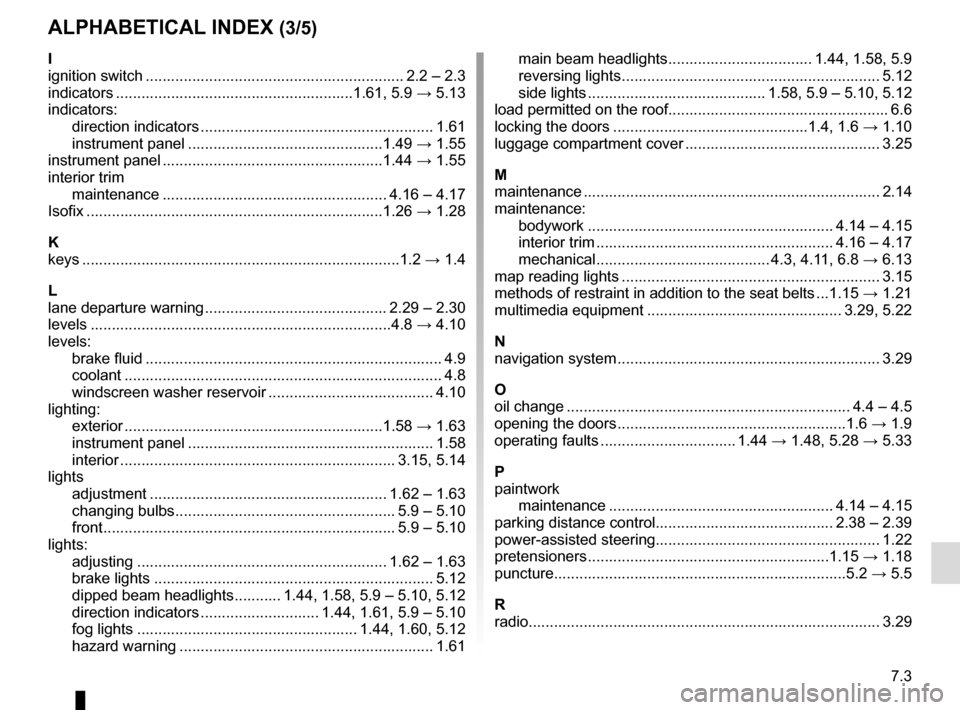
7.3
ALPHABETICAL INDEX (3/5)
I
ignition switch ............................................................. 2.2 – 2.3
indicators ........................................................1.61, 5.9 → 5.13
indicators: direction indicators ....................................................... 1.61
instrument panel ..............................................1.49 → 1.55
instrument panel ....................................................1.44 → 1.55
interior trim maintenance ..................................................... 4.16 – 4.17
Isofix .................................................................\
.....1.26 → 1.28
K
keys ...................................................................\
........1.2 → 1.4
L
lane departure warning ........................................... 2.29 – 2.30
levels .................................................................\
......4.8 → 4.10
levels: brake fluid ...................................................................... 4.9
coolant ................................................................\
........... 4.8
windscreen washer reservoir ....................................... 4.10
lighting: exterior .............................................................1.58 → 1.63
instrument panel .......................................................... 1.58
interior ...............................................................\
.. 3.15, 5.14
lights adjustment ........................................................ 1.62 – 1.63
changing bulbs .................................................... 5.9 – 5.10
front ..................................................................... 5.9 – 5.10
lights: adjusting ........................................................... 1.62 – 1.63
brake lights .................................................................. 5.12
dipped beam headlights ........... 1.44, 1.58, 5.9 – 5.10, 5.12
direction indicators ............................ 1.44, 1.61, 5.9 – 5.10
fog lights .................................................... 1.44, 1.60, 5.12
hazard warning ............................................................ 1.61 main beam headlights .................................. 1.44, 1.58, 5.9
reversing lights ............................................................. 5.12
side lights .......................................... 1.58, 5.9 – 5.10, 5.12
load permitted on the roof.................................................... 6.6
locking the doors ..............................................1.4, 1.6 → 1.10
luggage compartment cover .............................................. 3.25
M
maintenance ............................................................\
.......... 2.14
maintenance: bodywork .......................................................... 4.14 – 4.15
interior trim ........................................................ 4.16 – 4.17
mechanical ......................................... 4.3, 4.11, 6.8 → 6.13
map reading lights ............................................................. 3.15
methods of restraint in addition to the seat belts ...1.15 → 1.21
multimedia equipment .............................................. 3.29, 5.22
N
navigation system .............................................................. 3.29
O
oil change ................................................................... 4.4 – 4.5
opening the doors ......................................................1.6 → 1.9
operating faults ................................ 1.44 → 1.48, 5.28 → 5.33
P
paintwork maintenance ..................................................... 4.14 – 4.15
parking distance control.......................................... 2.38 – 2.39
power-assisted steering..................................................... 1.22
pretensioners .........................................................1.15 → 1.18
puncture.....................................................................5.2 → 5.5
R
radio........................................................................\
........... 3.29
Page 224 of 228
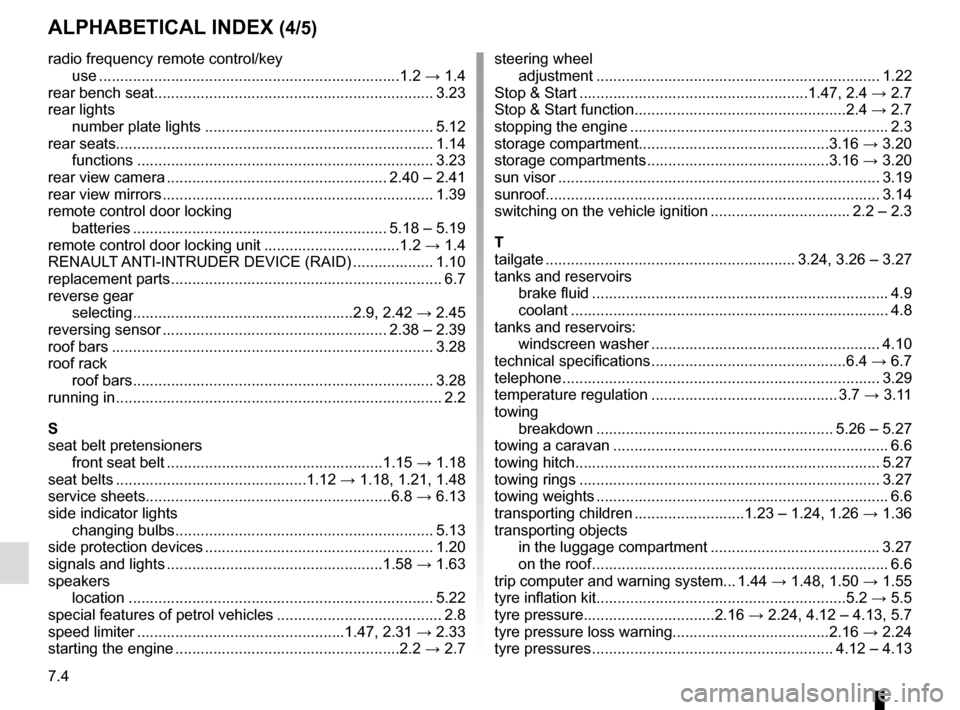
7.4
ALPHABETICAL INDEX (4/5)
radio frequency remote control/keyuse ....................................................................\
...1.2 → 1.4
rear bench seat.................................................................. 3.23
rear lights number plate lights ...................................................... 5.12
rear seats........................................................................\
... 1.14 functions ..............................................................\
........ 3.23
rear view camera .................................................... 2.40 – 2.41
rear view mirrors ................................................................ 1.39
remote control door locking batteries ............................................................ 5.18 – 5.19
remote control door locking unit ................................1.2 → 1.4
RENAULT ANTI-INTRUDER DEVICE (RAID) ................... 1.10
replacement parts ................................................................ 6.7
reverse gear selecting ....................................................2.9, 2.42 → 2.45
reversing sensor ..................................................... 2.38 – 2.39
roof bars ........................................................................\
.... 3.28
roof rack roof bars ....................................................................... 3.28
running in ........................................................................\
..... 2.2
S
seat belt pretensioners front seat belt ...................................................1.15 → 1.18
seat belts .............................................1.12 → 1.18, 1.21, 1.48
service sheets..........................................................6.8 → 6.13
side indicator lights changing bulbs ............................................................. 5.13
side protection devices ...................................................... 1.20
signals and lights ...................................................1.58 → 1.63
speakers location ...............................................................\
......... 5.22
special features of petrol vehicles ....................................... 2.8
speed limiter .................................................1.47, 2.31 → 2.33
starting the engine .....................................................2.2 → 2.7steering wheel
adjustment .............................................................\
...... 1.22
Stop & Start ......................................................1.47, 2.4 → 2.7
Stop & Start function..................................................2.4 → 2.7
stopping the engine ............................................................. 2.3
storage compartment.............................................3.16 → 3.20
storage compartments ...........................................3.16 → 3.20
sun visor ........................................................................\
.... 3.19
sunroof........................................................................\
....... 3.14
switching on the vehicle ignition ................................. 2.2 – 2.3
T
tailgate ........................................................... 3.24, 3.26 – 3.27
tanks and reservoirs brake fluid ...................................................................... 4.9
coolant ................................................................\
........... 4.8
tanks and reservoirs: windscreen washer ...................................................... 4.10
technical specifications ..............................................6.4 → 6.7
telephone ..............................................................\
............. 3.29
temperature regulation ............................................ 3.7 → 3.11
towing breakdown ........................................................ 5.26 – 5.27
towing a caravan ................................................................. 6.6
towing hitch........................................................................\
5.27
towing rings ....................................................................... 3.27
towing weights ..................................................................... 6.6
transporting children ..........................1.23 – 1.24, 1.26 → 1.36
transporting objects in the luggage compartment ........................................ 3.27
on the roof ...................................................................... 6.6
trip computer and warning system... 1.44 → 1.48, 1.50 → 1.55
tyre inflation kit...........................................................5.2 → 5.5
tyre pressure...............................2.16 → 2.24, 4.12 – 4.13, 5.7
tyre pressure loss warning.....................................2.16 → 2.24
tyre pressures ......................................................... 4.12 – 4.13
Page 225 of 228
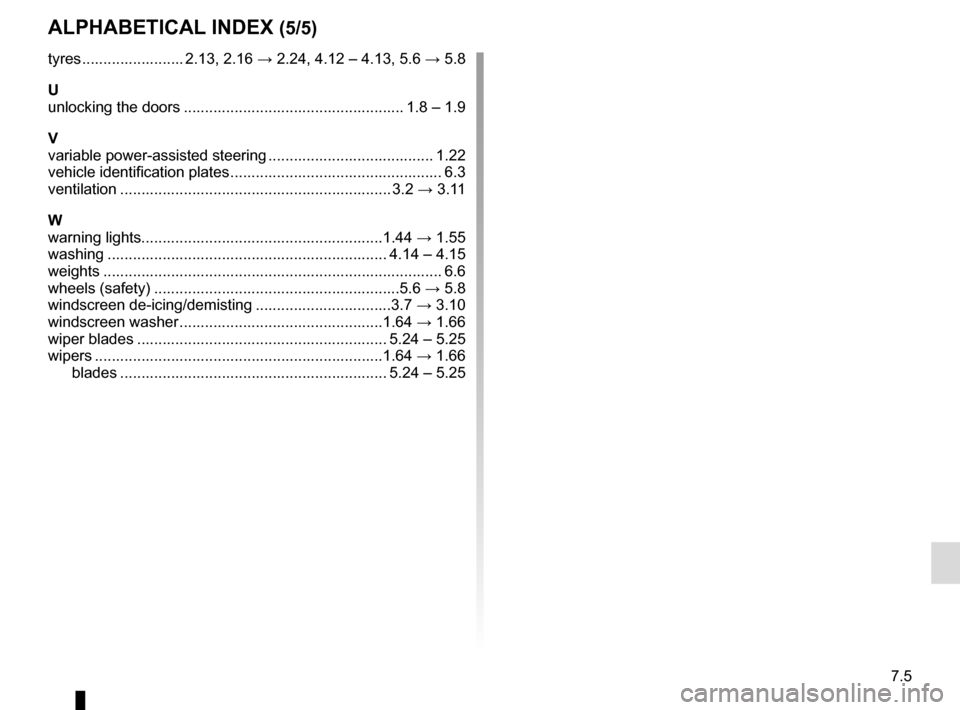
7.5
ALPHABETICAL INDEX (5/5)
tyres ........................ 2.13, 2.16 → 2.24, 4.12 – 4.13, 5.6 → 5.8
U
unlocking the doors .................................................... 1.8 – 1.9
V
variable power-assisted steering ....................................... 1.22
vehicle identification plates .................................................. 6.3
ventilation ............................................................\
.... 3.2 → 3.11
W
warning lights.........................................................1.44 → 1.55
washing .................................................................. 4.14 – 4.15
weights ................................................................\
................ 6.6
wheels (safety) ..........................................................5.6 → 5.8
windscreen de-icing/demisting ................................3.7 → 3.10
windscreen washer ................................................1.64 → 1.66
wiper blades ........................................................... 5.24 – 5.25
wipers .................................................................\
...1.64 → 1.66
blades ............................................................... 5.24 – 5.25